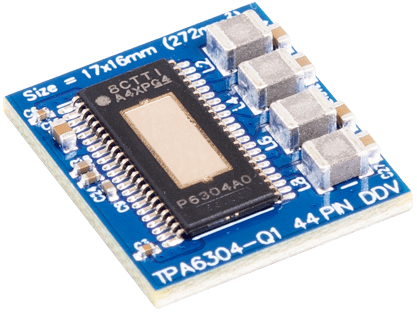ZHCSMX0B September 2019 – December 2020 TPA6304-Q1
PRODUCTION DATA
- 1 特性
- 2 应用
- 3 说明
- 4 Revision History
- 5 Pin Configuration and Functions
- 6 Specifications
- 7 Parameter measurement information
-
7 Detailed Description
- 7.1 Overview
- 7.2 Functional Block Diagram
- 7.3
Feature Description
- 7.3.1 Single-Ended Analog Inputs
- 7.3.2 Gain Control
- 7.3.3 Class-D Operation and Spread Spectrum Control
- 7.3.4 Gate Drive
- 7.3.5 Power FETs
- 7.3.6
Load Diagnostics
- 7.3.6.1
DC Load Diagnostics
- 7.3.6.1.1 Automatic DC Load Diagnostics at Device Initialization
- 7.3.6.1.2 Automatic DC Load Diagnostics During Hi-Z to MUTE or PLAY Transition
- 7.3.6.1.3 Manual Start of DC Load Diagnostics
- 7.3.6.1.4 Short-to-Ground
- 7.3.6.1.5 Short-to-Power
- 7.3.6.1.6 Shorted Load and Open Load
- 7.3.6.1.7 Line Output Diagnostics
- 7.3.6.2 AC Load Diagnostics
- 7.3.6.1
DC Load Diagnostics
- 7.3.7 Power Supply
- 7.3.8 Device Initialization and Power-On-Reset (POR)
- 7.3.9 Protection and Monitoring
- 7.3.10 Hardware Control Pins
- 7.4
Device Functional Modes
- 7.4.1 Internal Reporting Signals
- 7.4.2 Device States and Flags
- 7.4.3 Fault Events
- 7.4.4 Warning Events
- 7.5 Programming
- 7.6 Register Maps
- 8 Application Information Disclaimer
- 9 Power Supply Recommendations
- 10Layout
- 11Device and Documentation Support
3 说明
TPA6304-Q1 器件是一款采用 2.1MHz PWM 开关频率的四通道模拟输入 D 类 Burr-Brown™ 音频放大器,可实现经成本优化的解决方案,PCB 尺寸非常小,仅为 2.7cm2,具有高阻抗单端输入,启动/停止过程中可在低至 4.5V 的电压下全面运行。
TPA6304-Q1 D 类音频放大器的设计十分出色,可适用于入门级汽车音响主机,以作为系统设计的一部分提供模拟音频输入信号。与传统的线性放大器解决方案相比,D 类拓扑技术显著提高了器件效率。
输出开关频率既可以设置为高于 AM 频带,以便消除 AM 频带干扰并降低输出滤波器尺寸及成本;也可以设置为低于 AM 频带,以便进一步优化效率。
该器件采用带外露散热焊盘的 44 引脚 HTSSOP 封装。
器件信息
| 器件型号 | 封装(1) | 封装尺寸(标称值) |
|---|---|---|
| TPA6304-Q1 | HTSSOP (44) | 14.00mm x 6.10mm |
(1) 如需了解所有可用封装,请参阅数据表末尾的可订购产品附录。
 参考板
参考板